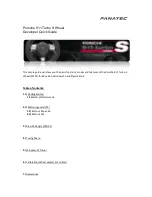
90
Check the brake disc. If its surface has deep notches and burrs,
remove it, clean and grind. When the disc wears to the thickness of 20.4
mm, replace it.
Check safety caps 5 and boots 8 for damages and proper installation
in seats, replace them, if necessary.
When replacing the shoes add UnIOl 2M/1 TU 38.5901243-92
grease under the boots of the brake guide bushes.
To replace the shoes move clip 3 until pistons 9 are on the inner
surface of crankcase 17. Bypass valve 14 can be opened to ease the fluid
displacement from crankcase 17. Close valve 14 as soon as pistons 9 are
completely sunk into the crankcase. Before moving clip 3 uncap the master
cylinder tank and do not let the fluid overflow while moving the clip.
It is forbidden
to recess the pistons with a tire iron as it can deform
the discs and damage the piston boots.
Replace worn brake shoes from both sides of the front axle shaft. To
bring the shoes to the disc press the brake pedal 2–3 times.
Install spring 1, spring carrier 18 and screw bolts 16.
ATTENTION!
Spring carrier 18 is asymmetric. Its long side shall
be mounted on crankcase 17 and its short side — on clip 3.
The necessary air gap between the brake shoes and the brake disc is
maintained automatically during the vehicle operation.
In ABS-equipped vehicles the calipers have recesses.
ATTENTION!
The brake disc bolts, the tubing T-connector, the
parking brake drive parts, the governor drive and the governor itself
are fixed with adhesive sealant (with no spring washers) to prevent
unscrewing. Add adhesive sealant if unscrewing these bolts and nuts.
rear Drum Brakes (Fig. 9.29).
Periodically remove brake drums
and clean the brake parts from dust and dirt. The cleaning frequency
depends on vehicle operation conditions. Clean the drums more often in
summer and when driving dirty roads and rarer in winter.
After the drums are removed make sure that wheel cylinders are
securely fixed to the shield. Pay attention to the condition of wheel
cylinders, safety caps 7 and to the condition of the brake drum.
Safety caps must be tightly installed in piston and cylinder seats and
not be damaged.
















































